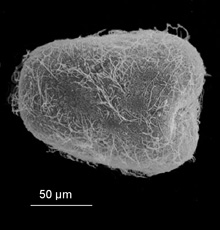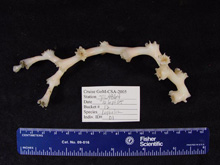
Scanning electron micrograph of 10 day old larva of Oculina varicosa, a deepwater coral that occurs off the east coast of Florida. Click image for larger view and image credit.
New Kids on the Block?
Tracking Coral Genes in the Deep Sea
Cheryl Morrison
Biologist
USGS-BRD, Leetown Science Center, Aquatic Ecology Branch
Coral Larvae - Going with the Flow?
Despite their biological and conservation importance, little is known about how deep-sea corals reproduce or the frequency of larval exchange between adult habitats. Like most sessile (attached to the sea bottom) marine invertebrates, larvae represent the dispersive part of the coral life cycle as they are carried by oceanic currents to new reefs. The length of larval life influences the degree of dispersal and changes between species. Fertilization of coral eggs can take place either internally or externally. With internal fertilization, development of the embryo is completed within polyps, and the coral releases fully developed larvae that are almost ready to settle and become attached to a surface for the remainder of their lives. Such species generally have short dispersal potential. External fertilization often leads to higher dispersal potential, as larvae remain in the water column for extended periods to be transported on ocean currents. Generally, increased dispersal should homogenize populations through a mixing of genes (gene flow) between adult populations.
Lophelia pertusa is an important deep-sea, reef-building coral occurring worldwide, including the Southeast coast of the U.S. and the Gulf of Mexico, yet little is known about its reproduction or degree of larval dispersal. Tissue analysis indicates that L. pertusa has external fertilization, as developing embryos have not been found (S. Brooke, pers. comm.). Although L. pertusa survive well in the lab, spawning has not occurred and larvae of L. pertusa have not yet been observed.

Sample of Lophelia pertusa coral collected for genetic analysis. Click image for larger view and image credit.
Molecular Tools for Tracking Coral Genes
Molecular techniques have significantly enhanced our ability to distinguish
related and morphologically similar taxa at a broad scale, and to delineate
the finest level of biological diversity (i.e., genetic diversity), providing
remarkably sensitive techniques for identifying, monitoring, and managing
species in need of conservation. We have developed microsatellite DNA
markers, which are highly variable, to characterize population structure
in L. pertusa from the Southeast coast of the U.S. and Gulf of Mexico.
Microsatellites are short repeats of DNA nucleotides, such as, 'AT-AT-
T' or 'GATA-GATA-GATA' that occur frequently in the nuclear genome.
The number of copies of the repeat region usually varies between individuals,
allowing us to tell individual corals apart and understand the genetic
structuring of populations. We survey the number of repeats a coral sample
has in order to get a genotype. The number of repeat copies is assessed
by separating out DNA fragments by size on a special type of gel matrix.
For each sample, many microsatellite regions are examined and a genotype
is obtained. We can then compare genotypes of individuals within a population
and get an idea about how the coral samples are related to each other.
For example, we can see how many of the samples may be clones (have the
same genotypes) or how many are close relatives (share a portion of alleles).
We can also estimate how often corals disperse between different populations
based upon numbers of shared alleles between populations. Since corals
can reproduce both sexually, promoting genetic diversity, as well as
asexually through fragmentation, genetic diversity estimates of reef
environments is complex. Use of
L.
pertusa microsatellites will provide information on the level of genetic
diversity and frequency of asexual reproduction present in the surveyed
L. pertusa.
The Future of Deep Reefs
From this work, we will obtain information regarding past and present connectivity among Lophelia reefs, and for the first time, inferences can be drawn about the degree of larval dispersal. Assessments can be made about levels of genetic diversity on different reefs. Such information is important to managers who are responsible for the protection of deep-sea Lophelia reefs. For example, if a reef was destroyed by fishing gear, oil exploration or other human activities, inferences on reef recovery rates can be made from knowledge of larval dispersal. Protected areas could be designed with consideration of dispersal limits, and predictions made regarding the location of undiscovered reefs.
























